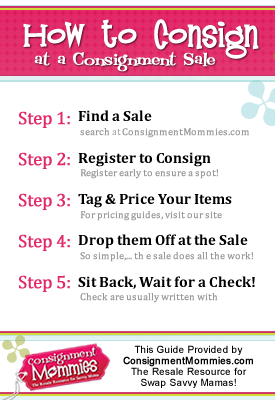
What is a Consignment Sale?
Typically, a week or weekend long event where consignors sell their items and receive 50-80% of the final item price for sold items. Sales are generally run by an owner or organizer and can be “for profit” or as a fundraiser for a school, church or other organization. Consignors select which items to consign and set their own prices. Consignment sales reward consignors with an additional commission % on their sold items in exchange for volunteer hours worked.
Want to ring in the New Year as a swap savvy consignment seller? Here are some tips collected from our community of today’s top consignors and power sellers to steer you in the right direction!
#1: Find a Sale
Research area consignment sales to determine which offers the best split to the seller, draws a significant amount of traffic annually, and has earned kudos from past shoppers. Some sales will even offer volunteer or referral perks that allow sellers early shopping privileges as well as increased percentage returns. Once you choose a sale, SIGN UP ASAP to be a consignor! Many sales are filling up consignor spots WELL BEFORE their deadlines so you don’t want to miss out!
#2: Take inventory
It’s time to clean out your kids’ closets and toy chests. Seek out the clothes and shoes they’ve outgrown and the toys that have lost their interest. You’ll be pleasantly surprised with the stash you gather and the extra storage space you clear to put away all the new presents your children received.
#3: It’s all about presentation
Just because your items aren’t brand new, doesn’t mean they shouldn’t look their best. Launder and iron all of the clothes you’ll consign. Ironing will help hide minimal pilling or fading and set your stuff apart from the rest. Toys should be cleaned and include all parts. All battery-operated toys must have working batteries included—if it’s supposed to play music or move, it better perform.
#4: Second time’s a charm
Every consignment sale will provide you with consigning instructions detailing tagging and pricing procedures. Take the time to read these instructions twice. No two sales are the same and you don’t want to miss out on the chance to sell your goods because you didn’t follow directions.
#5: The price is right
ConsignmentMommies.com consignors agree that a good pricing strategy is to price your items approximately one-third of what you paid at retail. Originally purchase a GapKids shirt for $15? Sell it gently-used at consignment for $5. Boutique items are typically priced 30 to 35 percent of retail.
#6: Time to tag
Tagging can be time consuming, but is totally worth the work. You’ll need to gather note cards or card stock, safety pins, clear packing tape and a pen. Most consignment sales require sellers to include their assigned consignor number, item size, brand name, brief description of the item and price. Some sales offer computerized or online tagging system to speed up the process. Either way, you’ll want affix those tags (securely) and then deliver your goods at drop-off of your chosen sale! Once you drop off your items, the sale will be responsible for the sale of your items for you.
Check out our new RESOURCES section for tips on tagging, pricing and more!
#7: Volunteer for More Perks (optional, but recommended)
With most sales, you don’t have to be present to sell your items. You just drop off your tagged items, pick up your unsold items at the end of the sale & then, wait for a check. However, by volunteering you can often get a higher percentage of your earnings and/or early shopping privileges! Plus, you’ll meet some awesome mamas along the way!!
